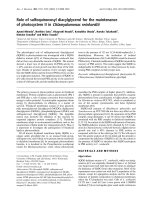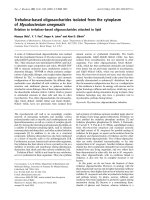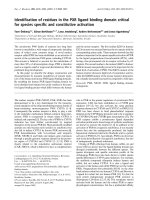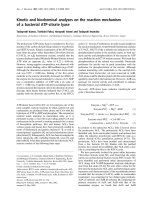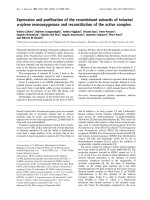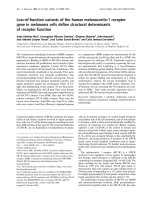Báo cáo y học: " Beyond open access: open discourse, the next great equalize" ppsx
Bạn đang xem bản rút gọn của tài liệu. Xem và tải ngay bản đầy đủ của tài liệu tại đây (305.19 KB, 3 trang )
BioMed Central
Page 1 of 3
(page number not for citation purposes)
Retrovirology
Open Access
Commentary
Beyond open access: open discourse, the next great equalizer
Andrew I Dayton*
Address: Laboratory of Molecular Virology, Division of Emerging and Transfusion Transmitted Diseases, Center for Biologics Evaluation and
Research, FDA, HFM 315 FDA/CBER, 1401 Rockville Pike, Rockville, MD, 20852-1448, USA
Email: Andrew I Dayton* -
* Corresponding author
Abstract
The internet is expanding the realm of scientific publishing to include free and open public debate
of published papers. Journals are beginning to support web posting of comments on their published
articles and independent organizations are providing centralized web sites for posting comments
about any published article. The trend promises to give one and all access to read and contribute
to cutting edge scientific criticism and debate.
If you are reading this you are benefiting from the Open
Access movement in scientific publishing. Open Access
reduces the great divide between the haves and have-nots
of the scientific world, allowing anyone, anywhere on the
planet with internet access to read with full text and
graphics the latest scientific reports, unfettered by prohib-
itive subscription fees or lack of affiliation with a major
institution to pay for them. That the process directly deliv-
ers to the public a product paid for by their taxes can only
be considered a just and additional benefit. But access to
cutting edge knowledge is not the only divide between the
haves and the have-nots. Even Open Access leaves a vast
inequality in scientific discourse. If you can't afford to
attend the latest scientific meetings (say, for instance, you
work for the US government) or are not a member of a
prestigious institution, you can be frozen out of cutting
edge scientific discussions. You can neither query the
major players nor contribute to the debates, unless your
prestige or the media value of the subject matter is such to
garner you a published letter to the editor. You can't even
witness the debates until they are published in review arti-
cles, by which time they are mostly over.
How often have you asked yourself how a certain study
was published unchallenged, without the results of a key
control? How often have you wondered whether a paper's
authors performed a specific procedure correctly? How
often have you had the opportunity to question authors
about previously published or opposing results they failed
to cite, or discuss the difficulties of reproducing certain
results? How often have you had the opportunity to com-
mand a discussion of an internal contradiction the refe-
rees seemed to have missed? The haves of science, who
benefit from the status quo they shepherd, have seldom felt
the need to redress such grievances. The have nots have
basically been stuck with their lot – until now.
Enter JournalReview.org [1], a website forum for open peer
review and discussion/criticism of medical literature.
Essentially an online journal club with free membership,
JournalReview.org provides a venue which will improve
communication among physicians and scientists and fos-
ter comment and criticism about published scientific
research. The goal is a better understanding and interpre-
tation of medical literature. JournalReview.org has no polit-
ical or commercial affiliations and was created solely by
the work of two physicians (Jeffrey Ellis, Adam Penstein),
Published: 30 August 2006
Retrovirology 2006, 3:55 doi:10.1186/1742-4690-3-55
Received: 19 June 2006
Accepted: 30 August 2006
This article is available from: />© 2006 Dayton; licensee BioMed Central Ltd.
This is an Open Access article distributed under the terms of the Creative Commons Attribution License ( />),
which permits unrestricted use, distribution, and reproduction in any medium, provided the original work is properly cited.
Retrovirology 2006, 3:55 />Page 2 of 3
(page number not for citation purposes)
one medical student (Lori Ellis) and one computer pro-
grammer (Aryeh Goldsmith).
How does it work? Simple: the site lists journals available
for discussion. Under the "Basic Science" heading are a
number of general purpose and specialty journals typi-
cally of interest to retrovirologists, including Nature, Cell,
Science and this journal, among others. In future it is
hoped the list of journals will grow in concert with inter-
est in Open Discourse. By navigating to the journal and
article of interest within a relevant discipline, anyone can
initiate, read, or add to a discussion as they see fit. Cur-
rently journals are listed according to discipline. Corre-
sponding authors are notified of comments submitted to
the discussions of their articles to facilitate timely
responses.
Central to the process is anonymity, which is the default
option if posters do not self identify in the post. Though
this can lead to abuses (and what human endeavor can
not?) it allows the unempowered of science to challenge
the empowered. But it would do a great disservice to Open
Discourse to promote it as supporting would be Davids
against reigning Goliaths. Just as Open Access distributes
primary knowledge, Open Discourse distributes debate. It
enables under privileged students, and even citizens, in
the third world to witness the unfolding of science in real
time. It can forewarn them of the drawbacks to seemingly
convincing, but flawed work, saving them time and possi-
bly resources. At another level, Open Discourse can raise
the quality of journal clubs by accelerating progress
through previously debated issues, and allowing partici-
pants to move on more quickly to the next levels of discus-
sion. It can accelerate mastery of a field by those newly
moving into it. And though the process may be painful for
authors, it will give them opportunity to publicly defend
their work and enlarge the discussion of it post publica-
tion. In short, everybody wins. Examples of discussions
underway can be found by navigating to the Dermatology
section of JournalReview.org [2] and choosing from the list
of "Recent Reviews." If this commentary is successful, I
hope you will find a similar list in the Basic Science sec-
tion [3].
JournalReview.org is not the sole source for Open Dis-
course. Retrovirology [4] and other BioMed Central journals
[5] already provide a specific tool for all interested partic-
ipants to submit comments (without anonymity, though)
about a published work using the "Post a Comment"
function, as illustrated in the accompanying figure (Fig.
1). A site similar to JournalReview.org, BioWizard [6], hosts
commentaries, but only on articles reached by searching
through PubMed [7], and requires posters to at least iden-
tify their institutions and cities. PLoS ONE [8] plans to
offer commentary on its publications, once it is launched.
Even the dowager empress of biological journals, Cell [9],
has ventured a cautious toe to the tide, inviting public
commentary on selectively "featured" articles. The con-
cept, it seems, is coming of age.
So let us invite ourselves to commit to Open Discourse.
Let us set the tone and establish the precedent of enlight-
ened debate that is public spirited, as well as public. Let us
refrain from contributing the inconsequential, the self
serving and the counterproductive. And above all, let us
remember that discourse need not be discourteous. I
encourage all of us to not only participate in this move-
ment, but to promote it. Tell a friend. Tell a mentor. Tell a
protégé. Start submitting comments. In the end the value
we receive will be the value we give. And the value to the
world will be greater still.
The author has no affiliation with JournalReview.org, Biowiz-
ard.com, PLoS ONE, nor any competing interests. Opinions
expressed in this publication reflect the professional views of the
author and should not be viewed as official policy of the US
Food and Drug Administration or the Government of the
United States. Additionally, the opinions expressed do not nec-
essarily represent those of Retrovirology
or its editorial board.
References
1. [].
2. [ />spage.php?specialty_id=5&sdesc=Dermatology].
3. [ />spage.php?specialty_id=28&sdesc=Basic+Science].
4. [
].
5. [
].
Retrovirology and other BioMed Central publications provide a "Post a comment" button to append commentary to their published articles, such as the one displayed [10]Figure 1
Retrovirology and other BioMed Central publications provide a
"Post a comment" button to append commentary to their
published articles, such as the one displayed [10].
Publish with BioMed Central and every
scientist can read your work free of charge
"BioMed Central will be the most significant development for
disseminating the results of biomedical research in our lifetime."
Sir Paul Nurse, Cancer Research UK
Your research papers will be:
available free of charge to the entire biomedical community
peer reviewed and published immediately upon acceptance
cited in PubMed and archived on PubMed Central
yours — you keep the copyright
Submit your manuscript here:
/>BioMedcentral
Retrovirology 2006, 3:55 />Page 3 of 3
(page number not for citation purposes)
6. [].
7. [
].
8. [
].
9. [
].
10. Costa L, Chen N, Lopes A, Aguiar R, Tanuri A, Plemenitas A, Peterlin
BM: Interactions between Nef and AIP1 proliferate multive-
sicular bodies and facilitate egress of HIV-1. Retrovirology 2006,
3:33.


